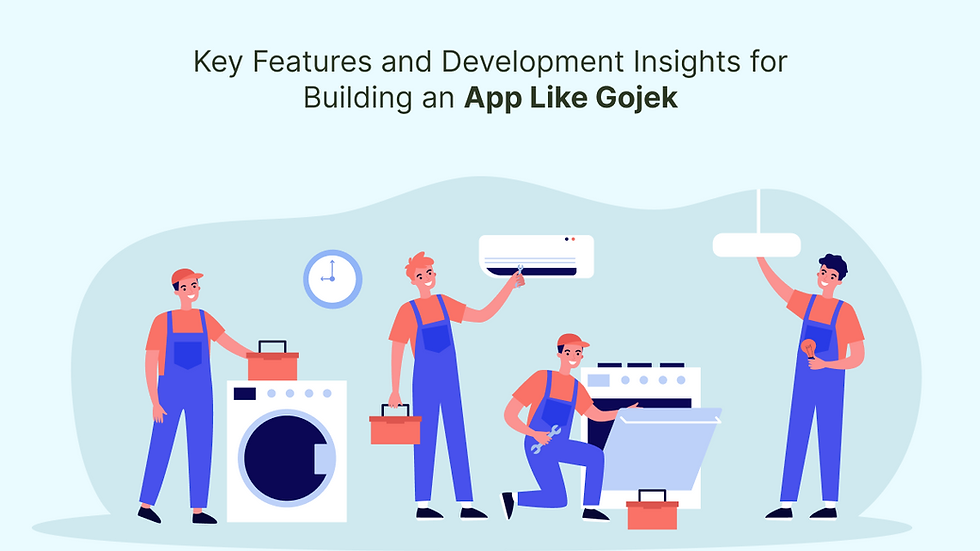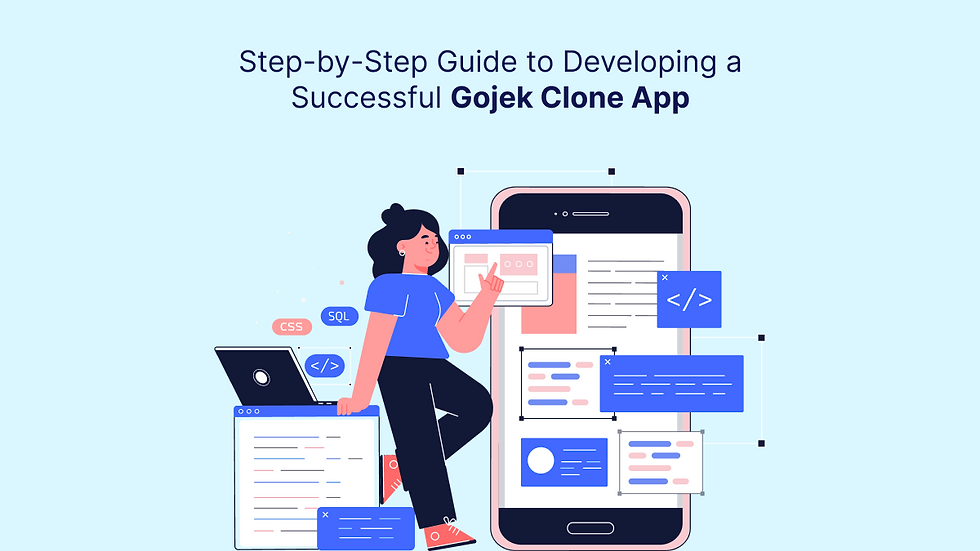Key Features and Development Insights for Building an App Like Gojek
- harryclark852
- Sep 8
- 4 min read
Updated: Sep 10

The success of multi-service platforms like Gojek has changed the way people access everyday services. From ride-hailing to food delivery and payments, Gojek has proven that combining multiple services into one app can create a loyal user base and strong revenue streams. If you are an entrepreneur or a business owner looking to launch a similar platform, understanding the key features and development insights is essential. This guide explains the must-have features, technology requirements, and tips to create an app like Gojek successfully.
Understanding the Multi-Service App Model
What Makes Gojek Unique
Gojek is more than just a taxi app. It integrates services like ride-hailing, food delivery, courier services, digital payments, and more into one seamless platform. This approach reduces the need for users to switch between multiple apps and increases engagement.
Benefits of a Multi-Service App
Multi-service apps create multiple revenue streams for businesses while providing convenience for users. They increase user retention, reduce marketing costs, and offer opportunities for cross-selling and upselling services.
Key Features of an App Like Gojek
User App Features
Simple Registration
Allow users to sign up via email, phone number, or social media accounts for faster onboarding.
Service Categories
Clearly display all services such as rides, food delivery, grocery, or courier services. This helps users find what they need quickly.
Real-Time Tracking
Show live locations of drivers or delivery agents to increase transparency and trust.
Multiple Payment Options
Include digital wallets, credit/debit cards, UPI, and cash options to ensure convenience for all users.
Ratings and Reviews
Enable users to rate services and drivers, which improves quality and builds credibility.
Push Notifications
Send updates about ride status, promotions, discounts, or offers to keep users engaged.
Driver App Features
Registration and Verification
Ensure drivers complete identity and vehicle verification for safety and compliance.
Trip Requests
Drivers should receive instant notifications about ride requests and be able to accept or reject them.
Earnings Tracker
Show daily, weekly, and monthly earnings along with ride history for transparency.
Navigation
Integrate GPS and maps to guide drivers efficiently to pickup and drop locations.
Ratings and Feedback
Allow drivers to rate users, which helps maintain service quality.
Admin Panel Features
Dashboard
A centralized dashboard to manage users, drivers, payments, and services efficiently.
Analytics and Reporting
Track app performance, revenue, and user engagement to make data-driven decisions.
Payment Management
Monitor transactions, commissions, and refunds to ensure smooth operations.
Service Management
Add, remove, or update services based on demand and business priorities.
Promotions and Offers
Manage discounts, referral campaigns, and loyalty programs to attract and retain users.
Technology Stack for Developing an App Like Gojek
Frontend Development
Use technologies like React Native or Flutter for cross-platform apps that work on both Android and iOS.
Backend Development
Node.js, Python, or Ruby on Rails are commonly used to handle server-side operations, APIs, and databases efficiently.
Database
Use robust databases like MySQL, PostgreSQL, or MongoDB to store user, driver, and transaction data securely. Read More: Gojek Clone App- On-Demand Multi Services App Development
GPS and Maps Integration
Google Maps API or Mapbox for real-time tracking, route optimization, and geolocation services.
Payment Gateway Integration
Integrate trusted payment gateways like Stripe, PayPal, Razorpay, or local payment systems for secure transactions.
Cloud Infrastructure
Use AWS, Google Cloud, or Azure to ensure scalability, security, and high performance.
Push Notifications
Firebase or OneSignal can be used to send real-time notifications to users and drivers.
Development Insights and Best Practices
Prioritize MVP
Start with a Minimum Viable Product (MVP) focusing on core features like ride-hailing and payments. You can add additional services later based on user feedback.
Focus on User Experience
A smooth, intuitive, and fast interface is critical to retain users. Test extensively to minimize bugs and crashes.
Ensure Security
Protect user data and transactions with encryption, secure authentication, and compliance with local regulations.
Scalability
Design your app and backend to handle increasing users and services without slowing down performance.
Regular Updates
Continuously update the app with new features, bug fixes, and performance improvements to maintain competitiveness.
Customer Support
Offer in-app chat, email, or call support to resolve issues quickly and improve user satisfaction.
Challenges to Consider
High Competition
The on-demand service market is crowded. Offering unique services or superior experience is necessary to stand out.
Regulatory Compliance
Different services may require licenses or permissions. Ensure your platform complies with local laws.
Maintaining Quality Across Services
Monitoring multiple services simultaneously can be complex. Implement strict quality control and feedback mechanisms.
Future Trends in Multi-Service Apps
AI-Powered Features
AI can help with demand prediction, personalized recommendations, route optimization, and dynamic pricing.

Voice and Chatbot Integration
Voice commands and chatbots can improve user convenience and reduce dependency on manual support.
Multi-City and Global Expansion
Scaling to multiple cities or countries requires robust infrastructure, localization, and regulatory compliance.
Integration of Financial Services
Adding in-app wallets, bill payments, and micro-loans can increase engagement and revenue.
Conclusion
Developing an app like Gojek requires careful planning, the right technology stack, and a focus on user experience. Key features include multi-service categories, real-time tracking, multiple payment options, ratings, and an efficient admin panel. Starting with an MVP, ensuring security, and planning for scalability are crucial for success. Entrepreneurs should also consider driver incentives, customer support, and regulatory compliance. Just like businesses evaluate development strategies before launching an uber clone, understanding these insights will help you build a successful, profitable, and sustainable multi-service platform.
FAQs
What is a Gojek-style app?
A Gojek-style app is a multi-service platform that offers ride-hailing, food delivery, courier services, payments, and other on-demand services in one app.
How much does it cost to develop an app like Gojek?
The cost depends on features, technology, location of development team, and platform. A basic MVP can cost less than a full-featured app.
Can I add more services after launching the app?
Yes, starting with core services and adding new ones later is a smart approach to manage costs and gather user feedback.
What technology stack is best for building a multi-service app?
Common choices include React Native or Flutter for frontend, Node.js or Python for backend, and MySQL or MongoDB for databases.
How can I make my app competitive?
Focus on user experience, efficient operations, attractive driver incentives, reliable customer support, and continuous updates to stay ahead in the market.




Comments